Pneumonia Done by: Aibek Bazilov, 206 A Checked
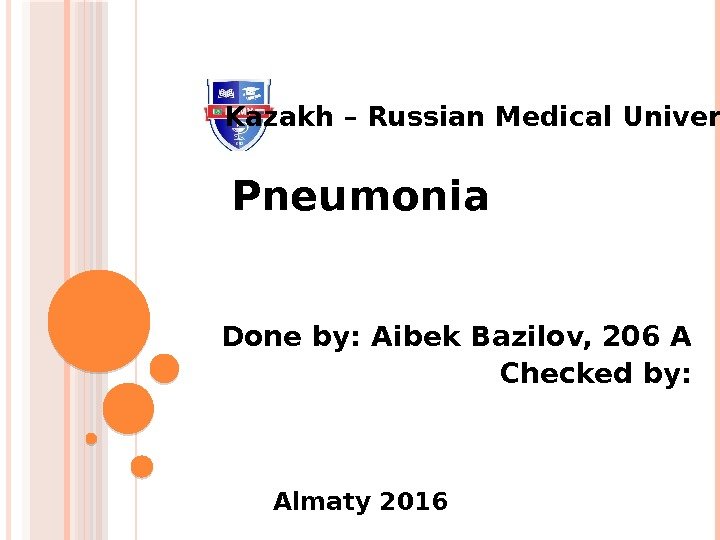
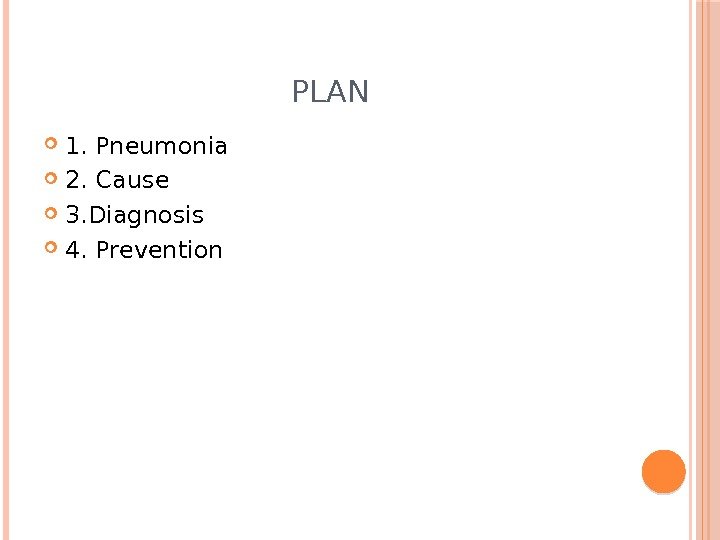
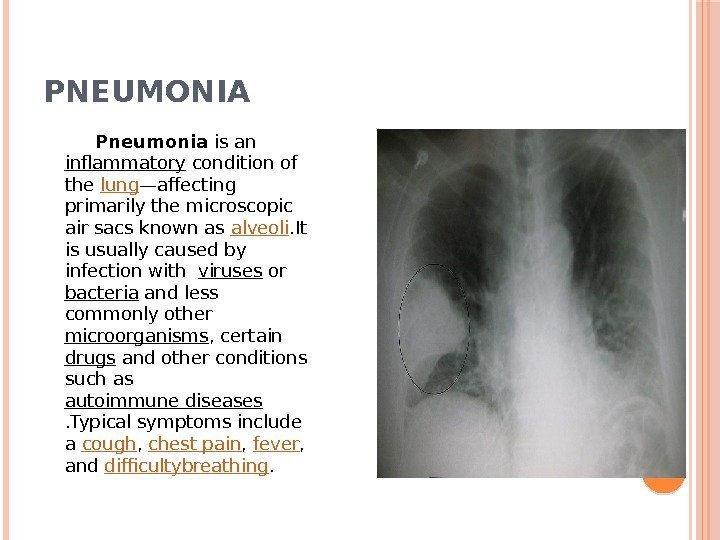
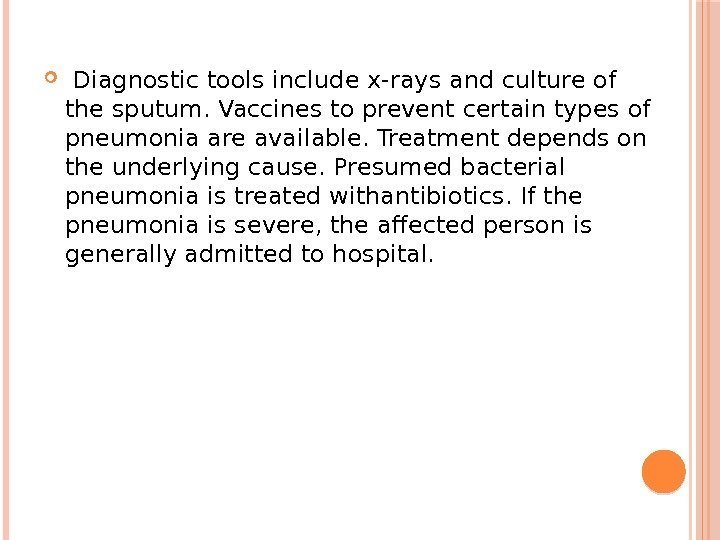
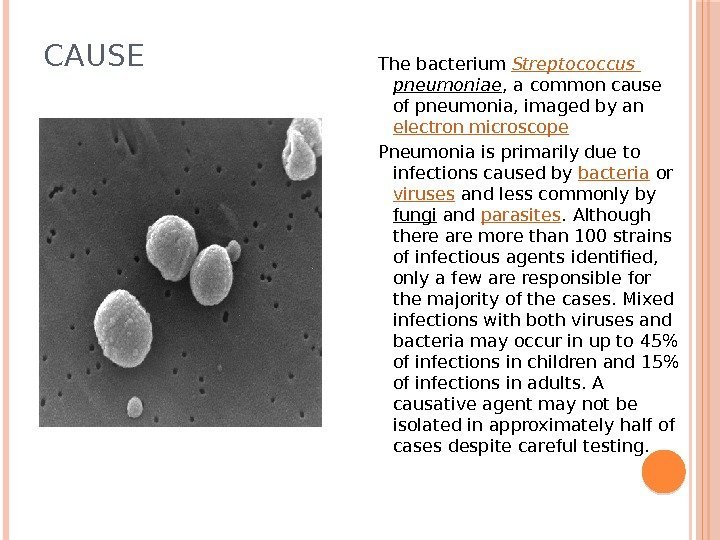
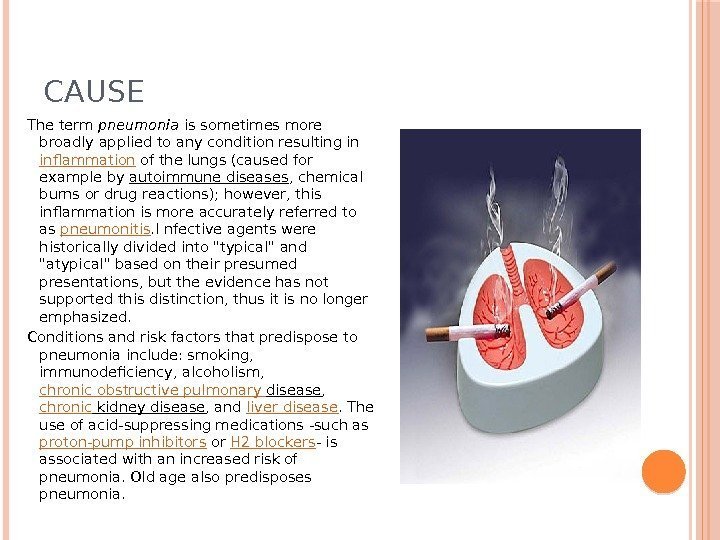
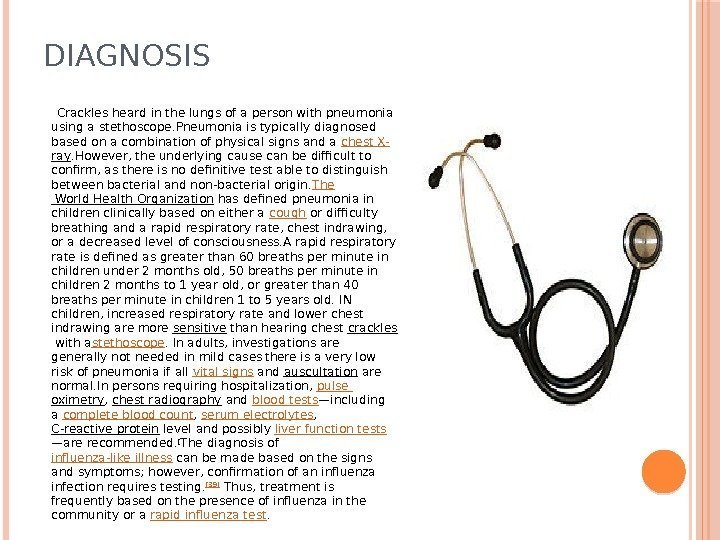
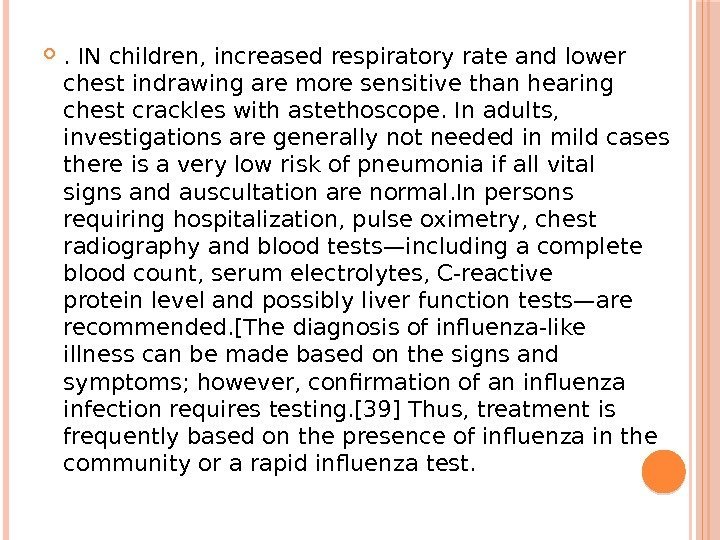
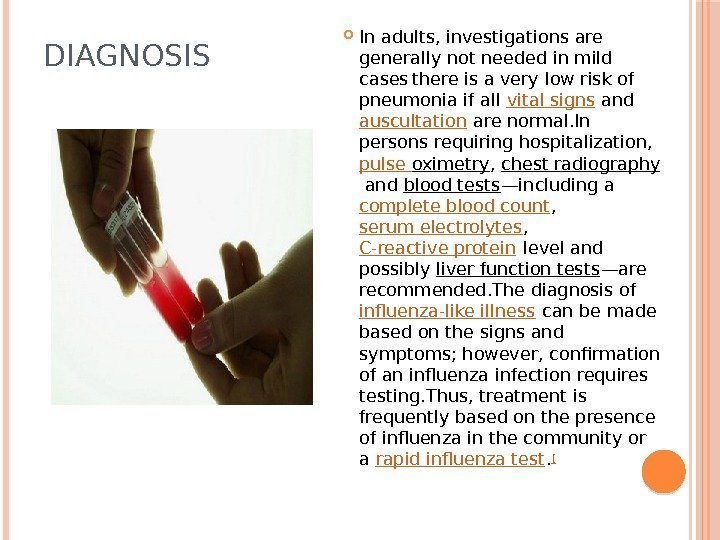
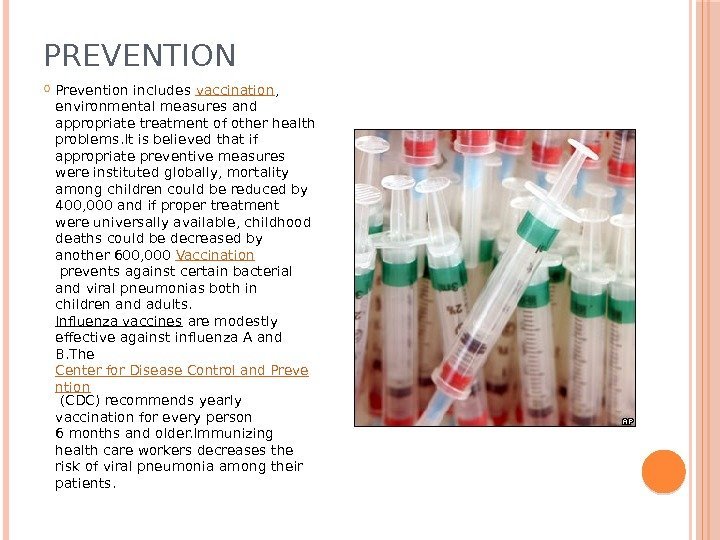
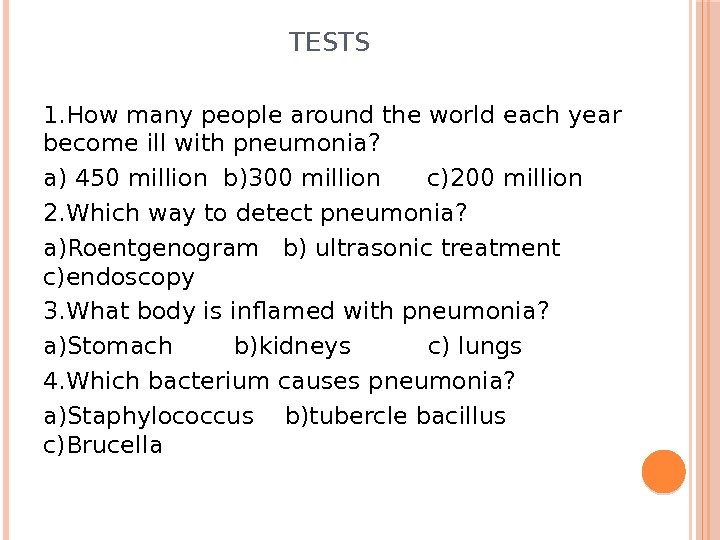

99540_dokonchity.pptx
- Размер: 268.6 Кб
- Автор: Айбек Базилов
- Количество слайдов: 12
Описание презентации Pneumonia Done by: Aibek Bazilov, 206 A Checked по слайдам
 Pneumonia Done by: Aibek Bazilov, 206 A Checked by: Almaty 2016 Kazakh – Russian Medical University
Pneumonia Done by: Aibek Bazilov, 206 A Checked by: Almaty 2016 Kazakh – Russian Medical University
 PLAN 1. Pneumonia 2. Cause 3. Diagnosis 4. Prevention
PLAN 1. Pneumonia 2. Cause 3. Diagnosis 4. Prevention
 PNEUMONIA Pneumonia is an inflammatory condition of the lung —affecting primarily the microscopic air sacs known as alveoli. It is usually caused by infection with viruses or bacteria and less commonly other microorganisms , certain drugs and other conditions such as autoimmune diseases . Typical symptoms include a cough , chest pain , fever , and difficultybreathing.
PNEUMONIA Pneumonia is an inflammatory condition of the lung —affecting primarily the microscopic air sacs known as alveoli. It is usually caused by infection with viruses or bacteria and less commonly other microorganisms , certain drugs and other conditions such as autoimmune diseases . Typical symptoms include a cough , chest pain , fever , and difficultybreathing.
 Diagnostictools include x-rays and culture of thesputum. Vaccinesto prevent certain types of pneumonia are available. Treatment depends on the underlying cause. Presumed bacterial pneumonia is treated withantibiotics. If the pneumonia is severe, the affected person is generally admitted to hospital.
Diagnostictools include x-rays and culture of thesputum. Vaccinesto prevent certain types of pneumonia are available. Treatment depends on the underlying cause. Presumed bacterial pneumonia is treated withantibiotics. If the pneumonia is severe, the affected person is generally admitted to hospital.
 CAUSE The bacterium Streptococcus pneumoniae , a common cause of pneumonia, imaged by an electron microscope Pneumonia is primarily due to infections caused by bacteria or viruses and less commonly by fungi and parasites. Although there are more than 100 strains of infectious agents identified, only a few are responsible for the majority of the cases. Mixed infections with both viruses and bacteria may occur in up to 45% of infections in children and 15% of infections in adults. A causative agent may not be isolated in approximately half of cases despite careful testing.
CAUSE The bacterium Streptococcus pneumoniae , a common cause of pneumonia, imaged by an electron microscope Pneumonia is primarily due to infections caused by bacteria or viruses and less commonly by fungi and parasites. Although there are more than 100 strains of infectious agents identified, only a few are responsible for the majority of the cases. Mixed infections with both viruses and bacteria may occur in up to 45% of infections in children and 15% of infections in adults. A causative agent may not be isolated in approximately half of cases despite careful testing.
 CAUSE The term pneumonia is sometimes more broadly applied to any condition resulting in inflammation of the lungs (caused for example by autoimmune diseases , chemical burns or drug reactions); however, this inflammation is more accurately referred to as pneumonitis. I nfective agents were historically divided into «typical» and «atypical» based on their presumed presentations, but the evidence has not supported this distinction, thus it is no longer emphasized. Conditions and risk factors that predispose to pneumonia include: smoking, immunodeficiency, alcoholism, chronic obstructive pulmonary disease , chronic kidney disease , and liver disease. The use of acid-suppressing medications -such as proton-pump inhibitors or H 2 blockers — is associated with an increased risk of pneumonia. Old age also predisposes pneumonia.
CAUSE The term pneumonia is sometimes more broadly applied to any condition resulting in inflammation of the lungs (caused for example by autoimmune diseases , chemical burns or drug reactions); however, this inflammation is more accurately referred to as pneumonitis. I nfective agents were historically divided into «typical» and «atypical» based on their presumed presentations, but the evidence has not supported this distinction, thus it is no longer emphasized. Conditions and risk factors that predispose to pneumonia include: smoking, immunodeficiency, alcoholism, chronic obstructive pulmonary disease , chronic kidney disease , and liver disease. The use of acid-suppressing medications -such as proton-pump inhibitors or H 2 blockers — is associated with an increased risk of pneumonia. Old age also predisposes pneumonia.
 DIAGNOSIS Crackles heard in the lungs of a person with pneumonia using a stethoscope. Pneumonia is typically diagnosed based on a combination of physical signs and a chest X- ray. However, the underlying cause can be difficult to confirm, as there is no definitive test able to distinguish between bacterial and non-bacterial origin. The World Health Organization has defined pneumonia in children clinically based on either a cough or difficulty breathing and a rapid respiratory rate, chest indrawing, or a decreased level of consciousness. A rapid respiratory rate is defined as greater than 60 breaths per minute in children under 2 months old, 50 breaths per minute in children 2 months to 1 year old, or greater than 40 breaths per minute in children 1 to 5 years old. IN children, increased respiratory rate and lower chest indrawing are more sensitive than hearing chest crackles with a stethoscope. In adults, investigations are generally not needed in mild cases there is a very low risk of pneumonia if all vital signs and auscultation are normal. In persons requiring hospitalization, pulse oximetry , chest radiography and blood tests —including a complete blood count , serum electrolytes , C-reactive protein level and possibly liver function tests —are recommended. [ The diagnosis of influenza-like illness can be made based on the signs and symptoms; however, confirmation of an influenza infection requires testing. [39] Thus, treatment is frequently based on the presence of influenza in the community or a rapid influenza test.
DIAGNOSIS Crackles heard in the lungs of a person with pneumonia using a stethoscope. Pneumonia is typically diagnosed based on a combination of physical signs and a chest X- ray. However, the underlying cause can be difficult to confirm, as there is no definitive test able to distinguish between bacterial and non-bacterial origin. The World Health Organization has defined pneumonia in children clinically based on either a cough or difficulty breathing and a rapid respiratory rate, chest indrawing, or a decreased level of consciousness. A rapid respiratory rate is defined as greater than 60 breaths per minute in children under 2 months old, 50 breaths per minute in children 2 months to 1 year old, or greater than 40 breaths per minute in children 1 to 5 years old. IN children, increased respiratory rate and lower chest indrawing are more sensitive than hearing chest crackles with a stethoscope. In adults, investigations are generally not needed in mild cases there is a very low risk of pneumonia if all vital signs and auscultation are normal. In persons requiring hospitalization, pulse oximetry , chest radiography and blood tests —including a complete blood count , serum electrolytes , C-reactive protein level and possibly liver function tests —are recommended. [ The diagnosis of influenza-like illness can be made based on the signs and symptoms; however, confirmation of an influenza infection requires testing. [39] Thus, treatment is frequently based on the presence of influenza in the community or a rapid influenza test.
 . IN children, increased respiratory rate and lower chest indrawing are moresensitivethan hearing chestcrackleswith astethoscope. In adults, investigations are generally not needed in mild cases there is a very low risk of pneumonia if allvital signsandauscultationare normal. In persons requiring hospitalization, pulse oximetry, chest radiographyandblood tests—including acomplete blood count, serum electrolytes, C-reactive proteinlevel and possiblyliver function tests—are recommended. [The diagnosis ofinfluenza-like illnesscan be made based on the signs and symptoms; however, confirmation of an influenza infection requires testing. [39]Thus, treatment is frequently based on the presence of influenza in the community or arapid influenza test.
. IN children, increased respiratory rate and lower chest indrawing are moresensitivethan hearing chestcrackleswith astethoscope. In adults, investigations are generally not needed in mild cases there is a very low risk of pneumonia if allvital signsandauscultationare normal. In persons requiring hospitalization, pulse oximetry, chest radiographyandblood tests—including acomplete blood count, serum electrolytes, C-reactive proteinlevel and possiblyliver function tests—are recommended. [The diagnosis ofinfluenza-like illnesscan be made based on the signs and symptoms; however, confirmation of an influenza infection requires testing. [39]Thus, treatment is frequently based on the presence of influenza in the community or arapid influenza test.
 DIAGNOSIS In adults, investigations are generally not needed in mild cases there is a very low risk of pneumonia if all vital signs and auscultation are normal. In persons requiring hospitalization, pulse oximetry , chest radiography and blood tests —including a complete blood count , serum electrolytes , C-reactive protein level and possibly liver function tests —are recommended. The diagnosis of influenza-like illness can be made based on the signs and symptoms; however, confirmation of an influenza infection requires testing. Thus, treatment is frequently based on the presence of influenza in the community or a rapid influenza test. [
DIAGNOSIS In adults, investigations are generally not needed in mild cases there is a very low risk of pneumonia if all vital signs and auscultation are normal. In persons requiring hospitalization, pulse oximetry , chest radiography and blood tests —including a complete blood count , serum electrolytes , C-reactive protein level and possibly liver function tests —are recommended. The diagnosis of influenza-like illness can be made based on the signs and symptoms; however, confirmation of an influenza infection requires testing. Thus, treatment is frequently based on the presence of influenza in the community or a rapid influenza test. [
 PREVENTION Prevention includes vaccination , environmental measures and appropriate treatment of other health problems. It is believed that if appropriate preventive measures were instituted globally, mortality among children could be reduced by 400, 000 and if proper treatment were universally available, childhood deaths could be decreased by another 600, 000 Vaccination prevents against certain bacterial and viral pneumonias both in children and adults. Influenza vaccines are modestly effective against influenza A and B. The Center for Disease Control and Preve ntion (CDC) recommends yearly vaccination for every person 6 months and older. Immunizing health care workers decreases the risk of viral pneumonia among their patients.
PREVENTION Prevention includes vaccination , environmental measures and appropriate treatment of other health problems. It is believed that if appropriate preventive measures were instituted globally, mortality among children could be reduced by 400, 000 and if proper treatment were universally available, childhood deaths could be decreased by another 600, 000 Vaccination prevents against certain bacterial and viral pneumonias both in children and adults. Influenza vaccines are modestly effective against influenza A and B. The Center for Disease Control and Preve ntion (CDC) recommends yearly vaccination for every person 6 months and older. Immunizing health care workers decreases the risk of viral pneumonia among their patients.
 TESTS 1. How many people around the world each year become ill with pneumonia? a) 450 million b)300 million c)200 million 2. Which way to detect pneumonia? a)Roentgenogram b) ultrasonic treatment c)endoscopy 3. What body is inflamed with pneumonia? a)Stomach b)kidneys c) lungs 4. Which bacterium causes pneumonia? a)Staphylococcus b)tubercle bacillus c)Brucella
TESTS 1. How many people around the world each year become ill with pneumonia? a) 450 million b)300 million c)200 million 2. Which way to detect pneumonia? a)Roentgenogram b) ultrasonic treatment c)endoscopy 3. What body is inflamed with pneumonia? a)Stomach b)kidneys c) lungs 4. Which bacterium causes pneumonia? a)Staphylococcus b)tubercle bacillus c)Brucella
 Thank you for attantion!
Thank you for attantion!
